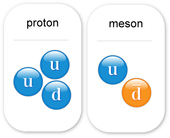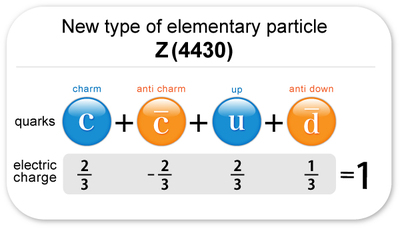Critical Discovery by Belle finally confirmed after 7 years
Highlights24 Apr, 2014
In 2007, one year before the awarding of the Nobel Prize to Profs. Kobayashi and Maskawa, the Belle collaboration at KEK reportedthe observation of the first electrically charged 4-quark state, the Z(4430), at the XXIII International Symposium on Lepton and Photon Interactions at High Energy, and then published this result in Physical Review Letters 100, 142001 (2008)
 "Standard" elementary particlesThis observation followed on the heels of Belle's 2003 discovery of the similarly enigmatic but electrically neutral X(3872) particle, published in Physical Review Letters 91, 262001 (2003). While the existence of the X(3872) was rapidly confirmed by CDF and DØ experiments at Fermilab and, later, by the BaBar experiment at SLAC, its nature has remained unsettled. Being neutral, it is challenging to distinguish the X(3872) from an ordinary charmonium resonance, consisting of charm and anti-charm quarks. The unexpected mass and quantum numbers of the X(3872) argue for the presence of two additional light quarks: a four-quark state.
"Standard" elementary particlesThis observation followed on the heels of Belle's 2003 discovery of the similarly enigmatic but electrically neutral X(3872) particle, published in Physical Review Letters 91, 262001 (2003). While the existence of the X(3872) was rapidly confirmed by CDF and DØ experiments at Fermilab and, later, by the BaBar experiment at SLAC, its nature has remained unsettled. Being neutral, it is challenging to distinguish the X(3872) from an ordinary charmonium resonance, consisting of charm and anti-charm quarks. The unexpected mass and quantum numbers of the X(3872) argue for the presence of two additional light quarks: a four-quark state.
The Z(4430), on the other hand, clearly contains the charm and anti-charm quarks and is electrically charged - as determined by Belle's original observation of its decay to the ψ(2S) π+ state - so it is unequivocally a four-quark combination of charm, anti-charm, up, and anti-down. Later, in 2013, Belle published a new and stronger paper on the existence as well as the determination of the spin, parity and charge-conjugation quantum numbers of the Z(4430) in Physical Review D 88, 074026. Meanwhile, Belle has discovered a cornucopia of similar exotic charmonium-like and bottomonium-like states within its copious data set, including the charged four-quark combinations of bottom, anti-bottom, up, and anti-down that was published in Physical Review Letters 112, 068103 (2013).
 New type of elementary particle , Z(4430) discovered by Belle in 2007 is now CONFIRMED by LHCb this month. The particle is thought to be composed of four quarks.
New type of elementary particle , Z(4430) discovered by Belle in 2007 is now CONFIRMED by LHCb this month. The particle is thought to be composed of four quarks.
Despite the two observations of the Z(4430) by Belle, there has remained a lingering uncertainty in the particle physics community about the existence of this new 4-quark state because it had not been seen in any other experiment. Now, the LHCb collaboration at CERN has provided incontrovertible confirmation of the Z(4430) charged 4-quark state seen first by Belle. The LHCb preprint was released on April 7, 2014 and is available at http://arxiv.org/abs/1404.1903.
Four-quark states are considered exotic because they do not follow the pattern of the known baryons (three-quark combinations) or mesons (quark-antiquark combinations). As such, they provide phenomenologists with additional ammunition to explore the detailed nature of quantum chromodynamics (QCD), the part of the Standard Model of particle physics that describes the interactions among quarks and that encompasses the possibility of four-, five- and even six-quark states. This more detailed understanding of the behavior of QCD may even have astrophysical implications extending to speculation about how the quarks in neutron stars are arranged.
詳しくは下記のページをご覧ください
http://